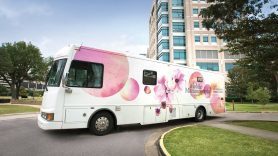Study finds mobile mammo patients aren't getting the follow-up imaging they need
por
Lauren Dubinsky, Senior Reporter | September 29, 2017

Mobile mammography van
Courtesy of MD Anderson
Mobile mammography vans are becoming a popular option for patients who don't want to travel to an imaging center, but how effective is it?
A study to be published in the December issue of the American Journal of Roentgenology found that mobile mammography patients aren't getting the follow-up imaging they need.
"Recently, mobile mammography programs have been utilized across the nation in hopes of bridging the gap in health care disparities by providing services to underserved populations," Elizabeth Stanley of the department of radiology at the Medical University of South Carolina, told HCB News. "With our study, we wanted to see if these goals were actually being met."
About one in eight women will develop invasive breast cancer over the course of their lifetime, according to breastcancer.org. This year an estimated 252,710 new cases of invasive breast cancer are expected to be diagnosed in women in the U.S.
A team of researchers led by Stanley evaluated all screening mammography exams that were performed in a mobile unit in 2014. For comparison, they also review an equivalent number of screening mammography exams performed at the MUSC's cancer center.
The team recorded BI-RADS assessments, adherence rates to follow-up recommendations, biopsies performed, cancer detection rates and sociodemographic factors. They also looked at other factors including age, location, health insurance status, race, marital status and geographical area.
The findings revealed the mobile mammography patient population was significantly less adherent to follow-up imaging recommendations compared to cancer center patients.
"It was surprising to discover that the mobile unit had a higher recall rate, i.e. a larger percentage of the mammograms were interpreted as suspicious, requiring diagnostic follow-up," said Stanley.
Those who visited MUSC's cancer center were significantly older than the mobile mammography patient population. In addition, over 38 percent of the mobile mammography group was uninsured, compared to about four percent in the cancer center group.
Slightly more Caucasian patients were screened at the cancer center, compared to African American and Hispanic patients. Marital status also made a difference with more single patients undergoing screening in a mobile van.
According to the study, the low adherence rate is likely due to the difficulties the mobile mammography population faces in accessing health care. Since they were more likely to be uninsured, that deterred them from going to a cancer center for follow-up.
A study published in Public Health Reports in 2010 proved that mobile mammography increases screening among patients with a low socioeconomic status. However, that's not very helpful if the patients don't show up for necessary follow-up imaging.
The MUSC researchers explained that the findings of the new study can be used to develop educational programs and targeted interventions to increase follow-up imaging among this population. One example is a text message reminder system that sends alerts to the mobile mammography patient population to remind them of any follow-up imaging that was recommended for them.
|
|
|
You Must Be Logged In To Post A Comment
|
